
[Guest Post] On Food and Cooking at MIT, Paradiso by CJ Q. '23
A selection of dishes that define my MIT dining experience, part 4
Why do I cook? It’s a question that many of my friends have asked me, and one that I often ask myself. Usually, I default to my “origin story” of coming to the US for college, getting disappointed by MIT dining hall food and by the greater Boston food scene in general, and resolving to replicate my favorite cuisines from around the world. That, however, is not the full reason. During my sophomore year, I started my food Instagram account @thefrenchdormitory, not just to document my culinary journey, but also as an attempt to prove that my cooking can provide nourishment to others.01 cj: good ol <em>nourishment</em> uh huh Junior year was a period of introspection, exploration, and experimentation. As I grappled with changes in my career and my personal life, I used cooking as a method to anchor myself to reality, as an attempt to rebuild the world around me in the spirit of “you are what you eat.” The results were rather macabre,02 cj: im not convinced jacky knows what macabre means. to be clear it does not mean “delicious” to say the least. Yet it is exactly this period of introspection that gave me new insights about food and led me to appreciate the culinary arts in a more personal, emotional way. Now, having been given this opportunity by CJ to write about the final year of my college culinary journey, I would like to expound on how I cook, why I cook, and why I cook the way I do.
I cook because it is the perfect hobby for a busy lifestyle. CJ commented that my freshman year blogpost screamed of “too much time on P/NR.” While that was certainly the case three years ago, my life has gotten much busier since. Dental school applications,03 cj: did you know jacky got a perfect score on whatever exam you have to take for dental school? that's not true but i hear he aced it two labs, a part-time job, and a fully registered load at MIT have placed me firmly on the “work” side of the work-life balance. And I will probably stay on that side for at least the next 8 years of my life as I pursue a DMD/PhD dual degree at Harvard. Looking back, I realized that aside from a few scattered moments of worry-free bliss such as freshman fall, I never had the time to fully unwind from work and develop full-time hobbies. This is certainly not a bad thing – I derive immense joy from my work in both academia and industry. However, like most “normal people”04 There aren’t a lot of those at MIT, I think I appreciate some good relaxation and recharging before waking up the next day and attempting to solve humanity’s dental problems. The solution I’ve found is to try appreciating the tiny moments in my daily life that I have to go through anyway: winding my watch05 cj: yes, jacky is the kind of person who owns the kind of watch you have to wind in the morning; picking a shirt, jacket, and tie to suit my mood; hitting the road for my commute; and, of course, savoring every bite of food that enters my mouth. It’s a “work hard play hard” mentality. I was surprised by how far a little extra effort can go in elevating the mundane into the realm of the extraordinary. Take the simple dish of beef stroganoff, which I demonstrated in my freshman fall blogpost. Add some white onion purée to the beurre blanc, trim the beef chuck, declutter the plating, and voilà! The humble family dish becomes something almost worthy of being called fine dining (Figure 1). It is a perfectly viable meal for unwinding after a long day at the office – hearty yet elegant, simple yet sophisticated. When life hits me with commitments and deadlines, I cut down on the clutter and let the ingredients do the talking. Spending four years at MIT has given me a newfound appreciation for the luxury of sitting down to enjoy a proper meal, and I am very grateful that I learned how to fit this “everyday luxury” into my busy schedule.

Figure 1. Beef Stroganoff. One of my favorite comfort foods, especially during the colder months. This is also one of the first dishes I tried to add my own twist to – in fact, it was my attempt to improve upon this dish that prompted me to buy a sous vide machine.
I cook because I take my hobbies way too seriously. Mea culpa! Like many at MIT, I am guilty of relentless perfectionism. I have allowed this “pursuit of excellence”, which has helped me tremendously in my career thus far, to trickle down into my avocations. I only realized this recently, when I looked at my schedule and realized that all my free time was filled with overblown pastimes that almost feel like trainings for alternate careers. What started as a love for wine turned into a WSET Level 3 Certification,06 There are only four levels with a 9-week course and an exam with theory and tasting components, for which I am still awaiting the results. What started as an enjoyment of driving led to car clubs, autocross days, and track events.07 Whether those events have made me a better driver is a different issue Cooking, however, remains my main hobby, and in four years I have progressed from “trying to cook”08 cj: to be <em>very clear</em>, jacky was already an amazing chef the moment he came into mit to “trying way too hard to cook.” Even with concrete benchmarks like certain classic dishes at Michelin star restaurants, perfection in cooking is difficult to measure and even more difficult to achieve. It requires a certain ethereal, immutable stroke of inspiration, as well as the ever-evolving skill of execution. During the past four years I have only came close to culinary perfection a handful of times. My own recipe for “Aged Foie Gras and French Toast”, in my opinion, is one of them (Figure 2) – it may not be the most striking, and it certainly isn’t the most complex, but it holds a special place in my heart because something about this combination just works so perfectly. The surprisingly simple recipe is detailed below in Appendix I.
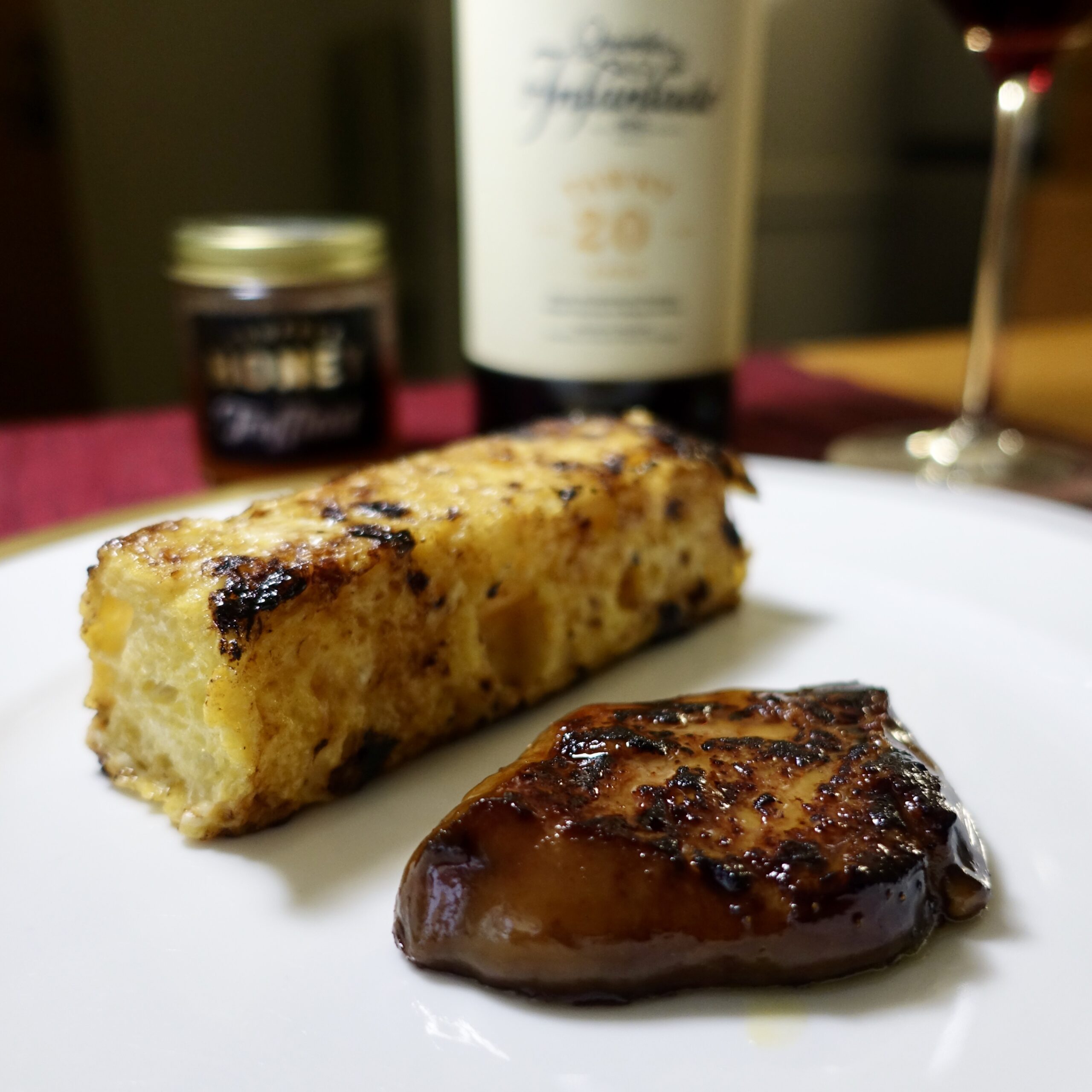
Figure 2. Aged Foie Gras / French Toast. The foie gras, aged in truffle honey for 18 days, melts in the mouth creating an explosion of floral, fig, and apricot flavors, ending in a sweet and fragrant finish. The French toast is coated with caramelized notes from honey and port, every bite releases mature aromas of smoke and vanilla like a glass of oaked chardonnay.
I cook because I am supported exactly by that which I destroy. My friend Keanu Clark ‘23, who I deeply admire, wrote this very philosophical blogpost: “The Free Play of Cliché: You are what you eat”, in which he argues that we are but the rearranged and reconstituted products of what we disintegrate. It follows that the nature of existence can be defined by what we can acquire without producing ourselves.09 cj: this is a pretty bold thesis Using the example of vitamins – molecules so common in our foods during the evolutionary process that we have lost the ability to synthesize them – Keanu refactors the cliché into “you are what you can comfortably forget.” Or, more accurately: “You are the problems that you can forget without risk of disintegration.” The act of “forgetting” extends beyond the level of metabolism. Take modern cuisine for example. Ingredients are disassociated from the culinary traditions that bind them, then integrated into a novel creation that bears semblance to its roots, yet is fundamentally its own unique entity. The process of formulating new recipes is also the process of freeing my mind from the confines of traditions that dictate how each ingredient should be used. It is the process of divorcing the physical substance of foods from the memories they carry, then transmuting the corporeal ingredients, in order to freely wield the memories associated with them (Figure 3). In my opinion, this is the reason restaurants like Per Se have such an enduring appeal: not just because of the exquisite taste of their dishes, but because of the memories they evoke, the memories that are freely deconstructed and reconstituted in accordance with the chefs’ visions.
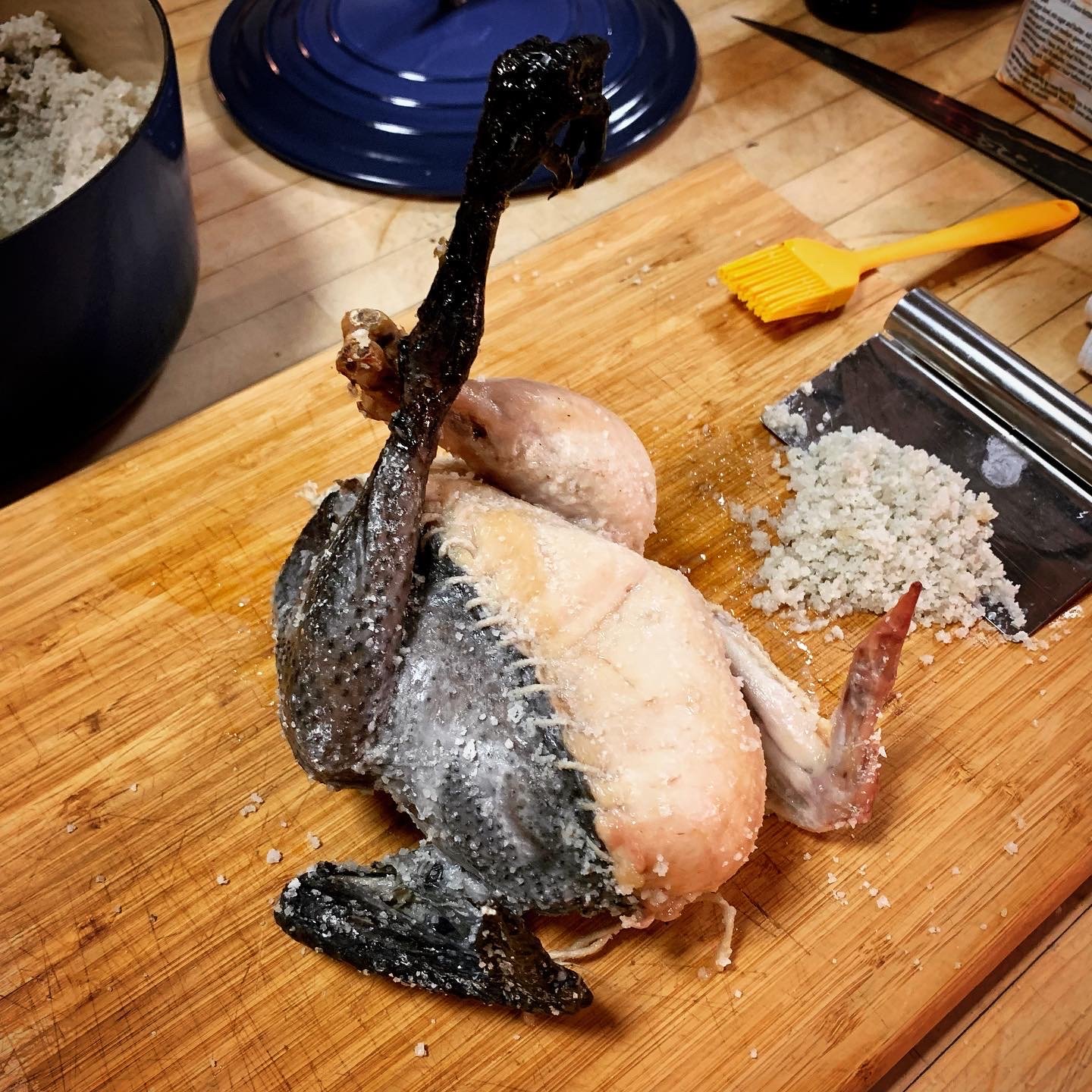
Figure 3. Half Chicken / Half Silkie Chicken. East meets West. Surgery meets cooking. When a Taiwanese silkie chicken and an American Giannone chicken are sutured together, encased in a salt crust, and baked, the normally dry silkie chicken takes on the moistness of regular chicken, while the regular chicken is imbued with the rich flavor of silkie chicken. Inspired by chef Alain Passard’s mi-poulet mi-canard.
I cook because I seek what lies beyond the horizon. To quote my philosopher friend Keanu again: “You are the questions you seek the answers to and the problems you attempt to solve.” Much of my cooking is driven by, on the most basic level, the desire to know what X would taste like when prepared using Y technique. I certainly still have my affinity for offal and exotic meats – a few days ago I heard about a chef in Taiwan who is making sushi from giant Bathynomus isopods, and I’m tempted to fly home just for a tasting. More recently, however, I explore by combining all the different lessons I’ve learned during the past few years. The monkfish dish shown in Figure 4 is a great example – it was wrapped in caul fat which I learned to use during junior year; served with a sauce I formulated as a sophomore; and prepared using sous vide techniques I picked up in freshman fall. What made this dish possible was not just knowing the techniques themselves, but having the imagination to combine the techniques in my mind and envisioning an end product. It turns out that the finished dish tasted very similar to what I imagined it would be like – silky smooth, balanced, and without any of the monkfish’s stereotypical fishiness.10 cj: the fish! it is fishy! how surprising
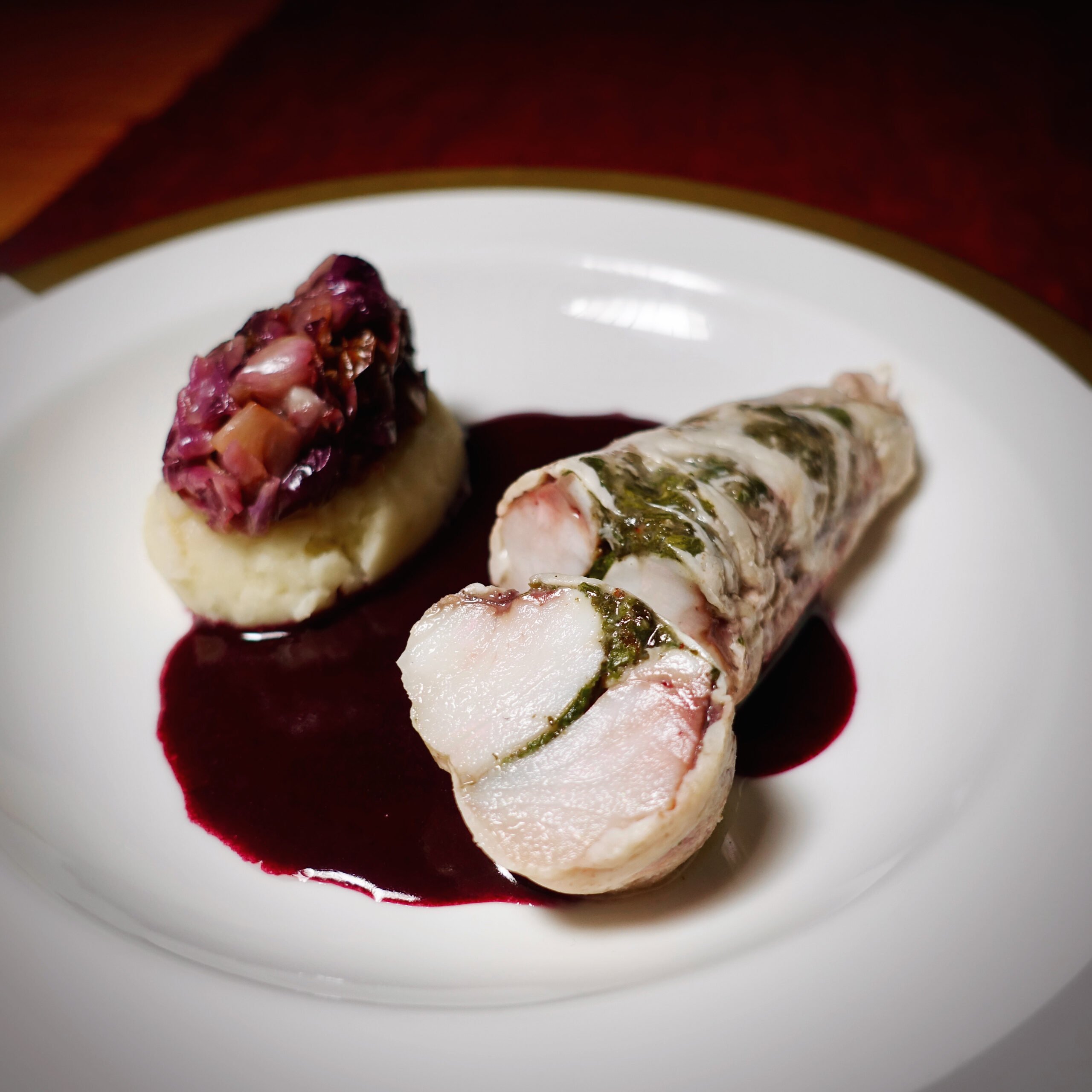
Figure 4. Monkfish with green sauce, red wine blackberry sauce, potato pureé, and radicchio. A short sous vide followed by chilling really brings out the silky texture of monkfish, while encasing the monkfish in caul fat with herbs neutralizes the fishiness.
I cook because it allows me to share my vision with others. During senior fall I joined MINCE (short for Massachusetts Institute of Culinary Experiences), a team of undergrad foodies who bring pop-up and pop-down dining experiences MIT, as a founding member. To me, MINCE represents a message: that even in the busy lives of MIT students, there is still value in discovering good food. By staging elaborate three course meals for diners, we try to convince our fellow students that food is more than just bodily sustenance, more than paying for calories and nutrients. Rather, it is nourishment for our hearts and souls.11 cj: cue the piano music This message is the same one that I wrote about in my previous blogposts, and I am overjoyed that I was able to find a group of like-minded people before I graduate. When it comes to my extracurricular activities at MIT, being the head chef for the “Night at the Art Gallery” pop-up was definitely the highlight of my undergraduate experience (Figure 5). Leading a team in planning recipes, coordinating food prep, managing logistics, figuring out décor, and serving thirty diners not only allowed me to share by vision, but also gave me newfound respect for the team effort it takes to make good food.

Figure 5. Slicing duck breast for the MINCE Art Gallery pop-up. The duck was part of a Mondrian-inspired dish called “duck breast three ways”, featuring ground spices, orange safflower jelly, and scallion aspic. The full recipe can be found on the MINCE website.
I cook because the pursuit of good food is inherently worthy. Enough said. Here’s a photo dump (Figures 6-8).
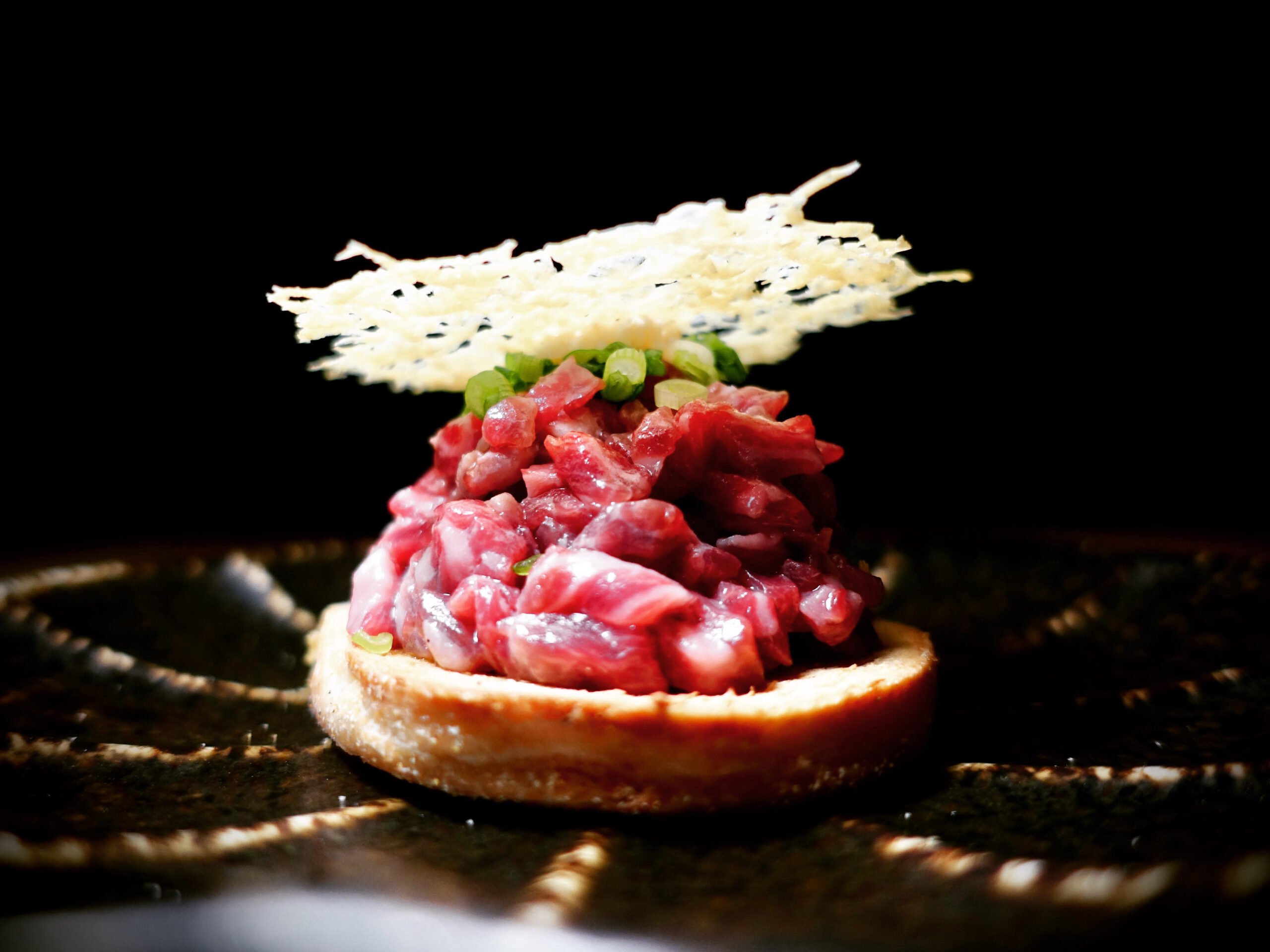
Figure 6. Cannibal Burger. Inspired by the Wisconsin cannibal sandwich. Prime beef chuck tartare, smoked sea salt, scallion, horseradish, sakekasu, ponzu, English muffin, pecorino tuile.
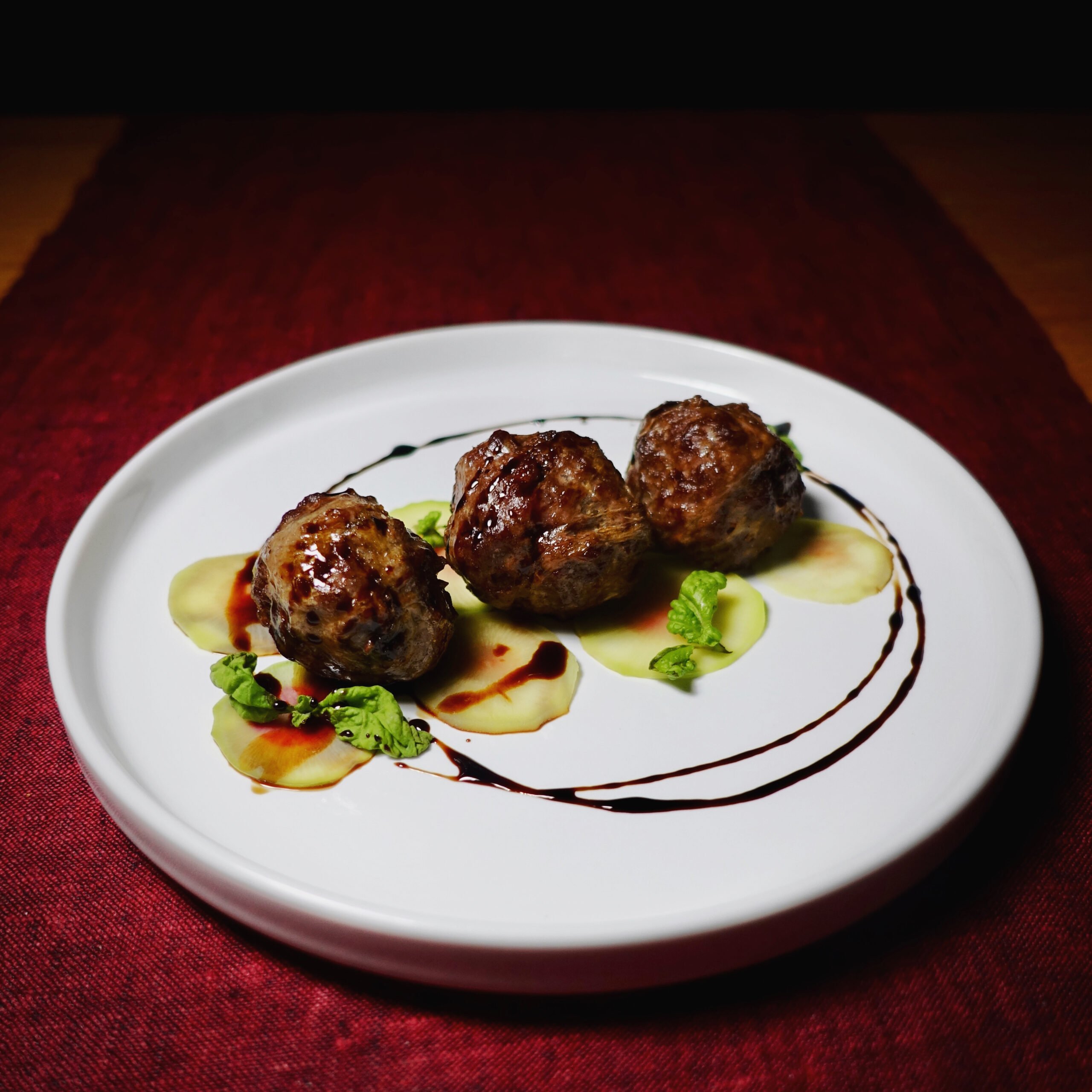
Figure 7. Camel Meatballs with Watermelon Radish. Wrapping the camel meat in caul fat before frying preserves the meat juices and concentrates the beefy flavors.
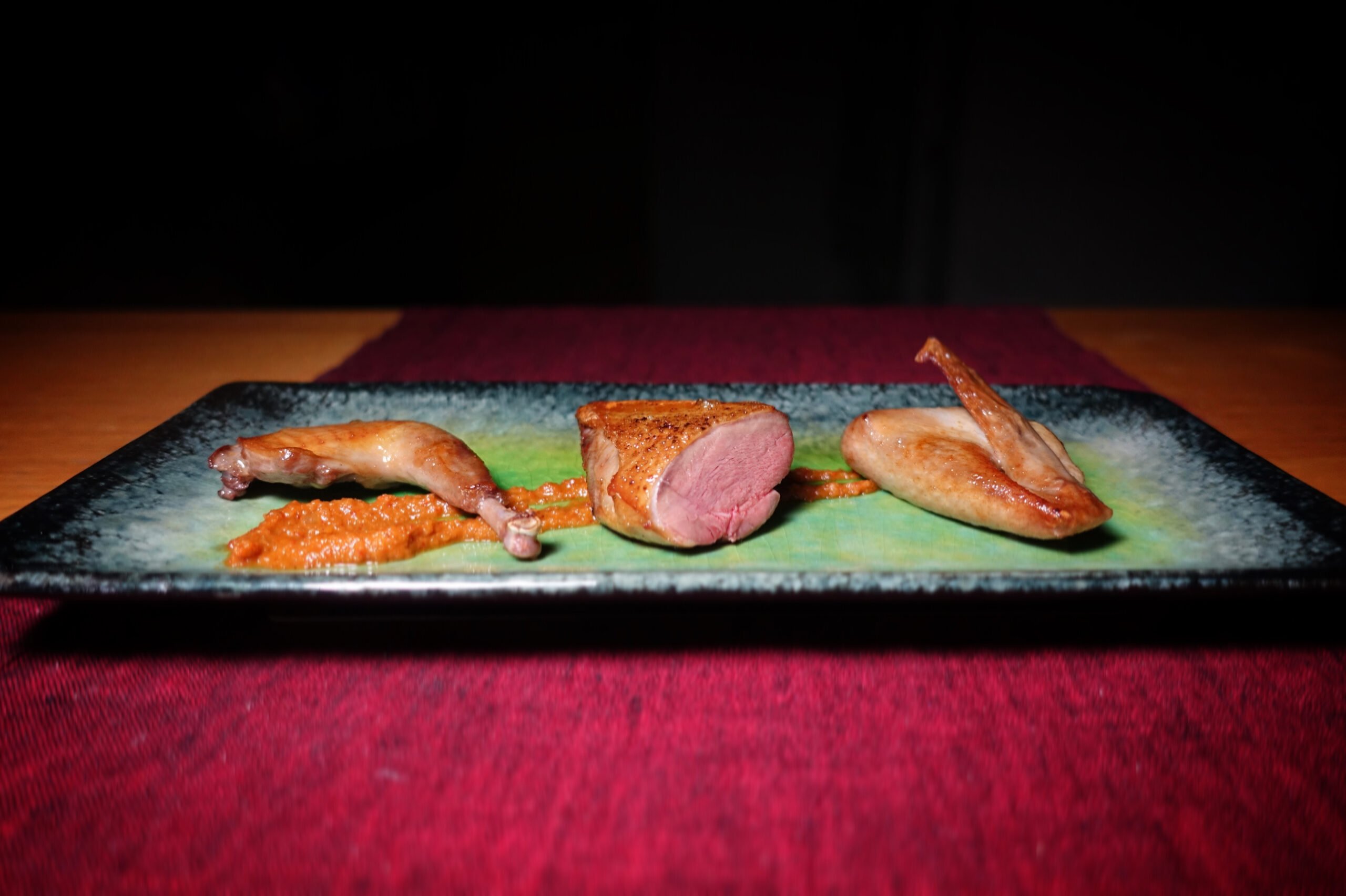
Figure 8. Poached Partridge with Pinot Pepper Pear Pureé. Inspired by the song Twelve Days of Christmas, which I heard for the first time at the Boston Pops concert.
I cook because it allows me to enshrine moments in time. This semester I took a class on Dante’s Inferno and Purgatorio,12 21L.320 Big Books during which I had a discussion with the professor regarding the nature of food metaphors in the Inferno. Professor Fuller pointed out that Dante’s Hell is timeless – souls neither repent nor change and have no hope for salvation. Even though metaphors for food, cooking, and ingestion abound, there is no “digestion” – the eaten are not assimilated into those who eat them. The process of eating does not proceed, but rather, only repeats and extends. On the surface, this seems to contradict many of the food metaphors in the Inferno, such as the description of Hell as a “toothed gullet” swallowing sinners, in canto 13. However, I reconciled this fact with my food-centric reading of the Divine Comedy by realizing that in a certain way, the process of eating itself can be timeless. Of course, there is the physical process of transformation during digestion, but when we remember a meal, we hardly ever focus on the process by which food is transformed into feces inside our gullet. Instead, our memory of food is fixed at a specific point in time, at the vanishing instant of when we encounter the food in our mouths. We remember the flavors and aromas of that one instant, long after the physical particles of food have degraded and scattered. In eating, therefore, food is made timeless: transformed from a physical body to an eternal profile of taste. Few processes capture this consecration of perishable moments into lasting memories better than winemaking. Last year I made banana wine using bananas from MIT’s famous Banana Lounge (Figure 9). After a year of bottle aging, the wine exhibited intense banana aromas13 cj: fun fact, the banana lounge smells like bananas and undergrads combined with dried fruit and nutty notes, reminiscent of the countless times I’ve rushed to the banana lounge for a quick lunch of three bananas and a coffee. It seems to me like the wine has great aging potential, and I’m sure that five, ten, or twenty years later, when I open a bottle of 2022 vintage banana wine from my cellar, I will be lovingly reminded of the time I spent at MIT drinking from the firehose.
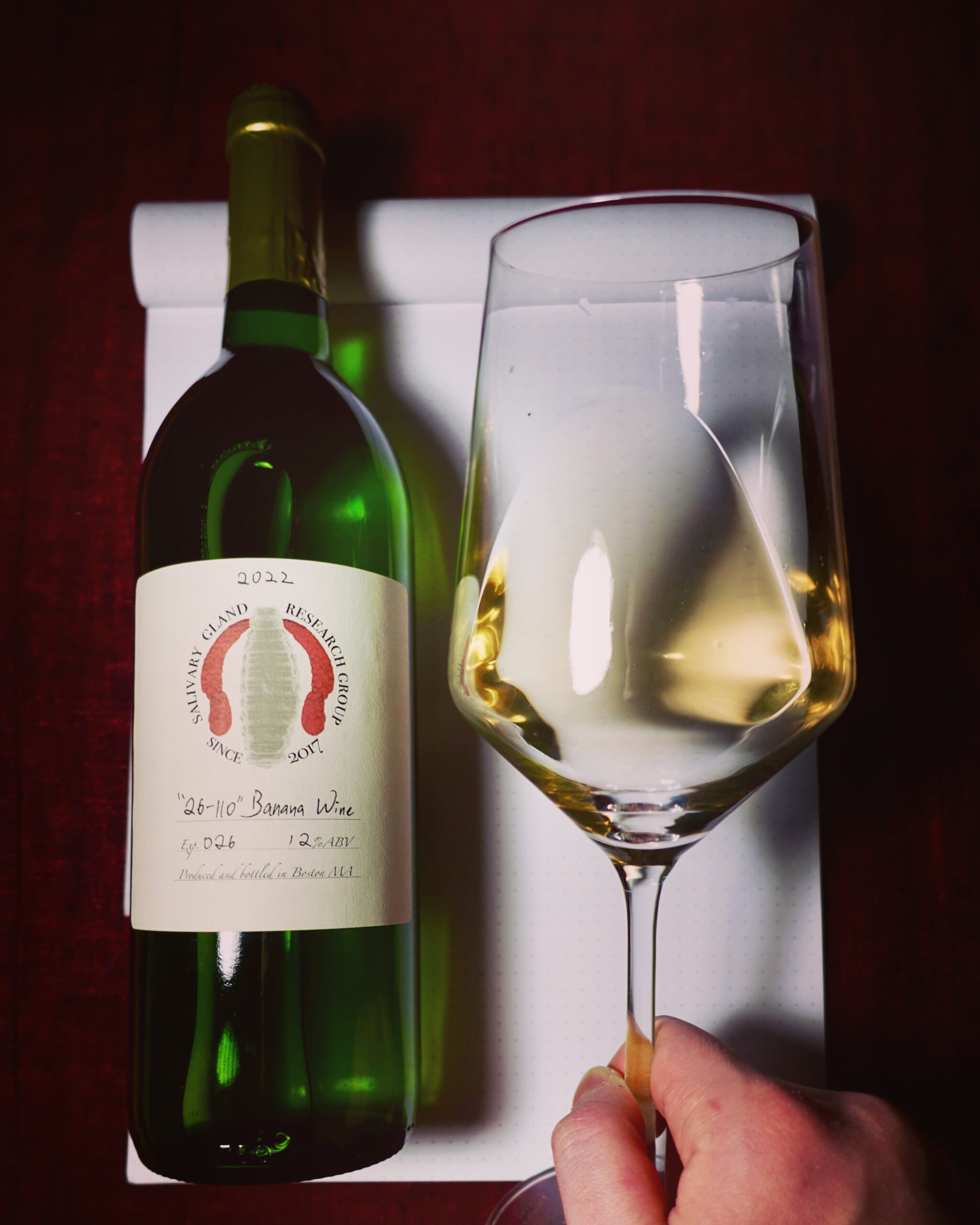
Figure 9. “26-110”14 Named after the room number of the banana lounge Banana Wine. It’s technically a mead because it’s made from bananas and honey. After malolactic fermentation and lees aging,15 cj: not a typo, actual term it’s similar to a Chardonnay but with extra banana aromas. Fun fact: I had the privilege of gifting a bottle to the team of students managing the banana lounge.
I thought I wouldn’t feel sentimental about leaving MIT, until the last day of classes. Professor Fuller, having taken us through Dante’s Hell and Purgatory, read us the final lines of Paradiso, where Dante sees God – the love that moves the sun and stars. There was a moment of silence. “Your work here is done,” she said. “Go forth and prosper.” Spending time at MIT wasn’t that different from journeying through the Inferno and Purgatorio.16 cj: what an enduring analogy. i wrote a whole post about <a href="https://mitadmissions.org/blogs/entry/tech-is-hell/">the history of comparing mit to hell</a> Beyond the psets and exams, college allowed me to recognize my shortcomings, repent, and attempt to rectify them. It opened my eyes to a higher calling and gave me the means to dedicate my life’s work towards it. I am glad that throughout this journey, I was able to develop not just my career aspirations in dentistry, but also cultivate my love for food and cooking. My appreciation for the culinary arts is not simply a hobby anymore – it is a lens through which I can glimpse true divine beauty. It is a cornerstone of my life that I can return to when faced with challenges: academic, professional, personal, and otherwise. I am grateful that MIT has allowed me to see this. To play with the oh-so common cliché: I Have Truly Found Paradiso.
Appendix I. A Recipe for Aged Foie Gras / French Toast
Rationale
Inspired by Taiwanese chef André Chang’s beeswax-aged duck foie gras, I modified this dish to instead start with fattier goose foie gras, and aged it directly in truffle honey and tawny port. The honey marinade and rendered foie gras were then used to prepare French toast.
Experimental Design
- Age foie gras – 2+ weeks
- Sear foie gras and chill
- Prepare French toast
Materials
- 1 foie gras
- some truffle honey
- some tawny port
- some brioche or sourdough
- 1 egg
Procedure
Aging foie gras
- Mix truffle honey and tawny port to create manageable consistency.
- Add foie gras to bag, seal and age for 2+ weeks.
Sear foie gras
- Using a hot knife, cut a thick slice of foie gras. Consider that foie gras collapses in height when seared.
- Score one side of the foie lightly.
- Sear for 45 seconds on each side. Keep the rendered fat in the skillet.
- Chill the foie in the freezer on a metal tray.
Prepare French toast
- Cut brioche or sourdough into a strip.
- Mix an egg with the foie gras marinade.
- Soak bread in the marinade, then sear the bread in the rendered foie gras fat.
- Sear until caramelized spots appear on the bread.
- Serve foie gras cold and brioche hot.
- cj: good ol nourishment uh huh back to text ↑
- cj: im not convinced jacky knows what macabre means. to be clear it does not mean “delicious” back to text ↑
- cj: did you know jacky got a perfect score on whatever exam you have to take for dental school? that's not true but i hear he aced it back to text ↑
- There aren’t a lot of those at MIT, I think back to text ↑
- cj: yes, jacky is the kind of person who owns the kind of watch you have to wind back to text ↑
- There are only four levels back to text ↑
- Whether those events have made me a better driver is a different issue back to text ↑
- cj: to be very clear, jacky was already an amazing chef the moment he came into mit back to text ↑
- cj: this is a pretty bold thesis back to text ↑
- cj: the fish! it is fishy! how surprising back to text ↑
- cj: cue the piano music back to text ↑
- 21L.320 Big Books back to text ↑
- cj: fun fact, the banana lounge smells like bananas and undergrads back to text ↑
- Named after the room number of the banana lounge back to text ↑
- cj: not a typo, actual term back to text ↑
- cj: what an enduring analogy. i wrote a whole post about the history of comparing mit to hell back to text ↑